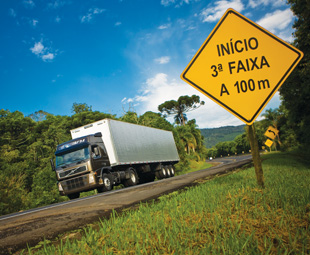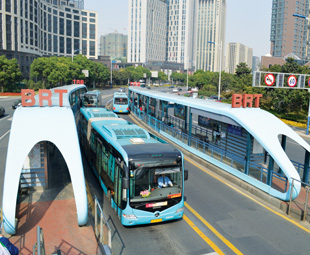Lending a (mutual) helping hand

South America is made up of developing and emerging markets. It’s not surprising, therefore, that various companies want to get in on the action. This region does, however, present numerous challenges … but original equipment manufacturers aren’t letting these get in the way.
During the last few years, South America (and specifically the Latin American region) has grown in importance for original equipment manufacturers (OEMs) the world over, as its developing markets show a lot of promise …
Martin Ståhlberg, head of Scania’s Latin American operations, explains: “Latin America today represents about 20 percent of Scania’s vehicle deliveries, and the region has accounted for reasonably stable growth in recent years, despite the economic downturn during 2008 and 2009.”
Latin America isn’t only Scania’s second biggest region, it’s also an important region for the world, with its different countries presenting various demands, conditions and, unfortunately, challenges …
According to statistics from companies linked to the freight carrier segment and insurance industries – as mentioned in the Volvo Group’s 2012 Sustainability Report – close to 91 000 accidents involving freight vehicles occur every year in Brazil. “In these accidents, 12 000 people die, and approximately 4 000 of them are truck drivers,” the publication relates.
Atlas da Acidentalidade no Transporte Brasileiro (loosely translated as “the Atlas on Brazilian accidents in transport”) – published by the Volvo Traffic Safety Programme (VTSP)* earlier this year – adds to this tragic picture as it details the main causes of accidents involving commercial vehicles, and the sections with the highest number of accidents and deaths on the four busiest highways in the country.
These include the Presidente Dutra (colloquially known as Via Dutra – which forms part of the BR-116, one of Brazil’s most important highways – connecting the cities of São Paulo and Rio de Janeiro), the Régis Bittencourt (another section of the BR-116, reportedly considered as one of the most dangerous highways in Brazil, connecting São Paulo to Curitiba in the South Region), Fernão Dias (which runs in the state of São Paulo and, northwards, in the southern region of Minas Gerais) and BR-040 (connecting Brasilia to Rio de Janeiro).
 According to the study, in 2012, more than 70 000 of the accidents from the highway quartet involved commercial vehicles. These, sadly, resulted in 4 230 deaths, but the totally unacceptable number of lives being lost, forms only part of the devastation being suffered …
According to the study, in 2012, more than 70 000 of the accidents from the highway quartet involved commercial vehicles. These, sadly, resulted in 4 230 deaths, but the totally unacceptable number of lives being lost, forms only part of the devastation being suffered …
Peter Cooke, a VTSP consultant, elaborates: “The problem of accidents and fatalities, involving commercial vehicles, is extremely serious. It entails losses that would adversely affect one of the key sectors needed to develop the country.” He adds that statistical work is paramount, as the dimensions of a problem are needed in order to address its causes.
In 2012, both truck and bus accidents happened in greater numbers during the week, but were more lethal over weekends. For trucks, Saturdays saw 81 deaths per 1 000 accidents and Sundays 106 for the same total.
A lack of attention led to the most accidents (21 860 out of 2012’s 62 852 truck crashes), but the accidents with higher mortality were caused by improper overtaking (accounting for 2 036 crashes), followed by alcohol abuse
(1 286 accidents) and speeding (which led to 5 368 collisions).
For buses, weekends looked worse than weekdays. Saturdays averaged 116 deaths per 1 000 accidents and Sundays 138. In 2012, there were 10 630 accidents on federal highways involving buses. Inattention was also a major reason for collisions, but dozing off at the wheel was the primary cause of lethal occurrences. Improper overtaking, speeding and “driving under the influence” played their part as well.
These figures, however, didn’t stop Volvo Trucks Brazil joining the vision of “Zero Accidents”, launched by the Volvo Group in Europe, in July this year. “It’s a pretty bold and challenging goal, which reflects and reinforces the brand’s commitment to safety in commercial transport,” says Solange Fusco, corporate communications manager of the Volvo Group Latin America.
To achieve this goal, the VTSP is developing a series of actions to engage the brand dealers, customers, carriers, employees, suppliers, government and society in its vision of zero accidents.
Anaelse Oliveira, the coordinator of the VTSP, adds: “Even with the vehicles considered the safest in the market, we know that they alone cannot prevent all accidents.” She says that the Group wants to join other efforts to reduce accidents. “To achieve this ideal future, it is important to have the involvement of enterprises and organisations in the transport sector, which will directly benefit from the increased safety and reduced human and financial losses resulting from accidents.”
To engage stakeholders, Volvo is hosting the Volvo Traffic Safety Award, which recognises practices that contribute effectively to the reduction of accidents involving commercial vehicles. The company is also engaging stakeholders, through various mobilisation campaigns, both regionally and nationally, and promoting debates on topics regarding security in commercial transport.
Brazil, however, isn’t the only country where the Volvo Group is showing its commitment to the transport industry, as it has opened new headquarters in Buenos Aires, Argentina, which include a 1 500 m2 multi-dealership for Renault Trucks, Volvo Trucks and Volvo Buses.
“We strive for customer satisfaction, and with these new facilities we’ll be able to provide even better service for all our brands,” says Giovanni Bruno, director general of the Volvo Group in Argentina, at the inauguration of the dealership.
Volvo states that this new facility is part of an ambitious expansion and renovation of the dealer network, and new points of customer service, in different regions within the country.
Bruno adds: “This is a great moment for the Group. It is accepting the challenge to further strengthen its operations in the region, in response to the trust that our customers have shown through their increasing preference of our products.” He says that the Group is committed to expanding its ability to take care of its vehicles throughout the country …
It’s clear that OEMs aren’t only seeing this sub-continent (and particularly the Latin American region) as a place for growth, they are investing in the safety of its road users and enhancing the services to the operators in these developing markets as well … a win-win situation for all involved.
*VTSP was launched by the Volvo Group in the late 1980s to help lower traffic accidents and death rates in Brazil, which are among the highest in the world. It has become the country’s longest running traffic alleviation programme, mobilising governments, traffic agencies, businesses, schools and universities as well as the media and the general public.
Published by
Focus on Transport
focusmagsa




